Tour & Design
True to the Turbines' name, the back of the ear buds do, indeed, look like a pair of turbines. Towards the front of the ear buds have blue and red rings, which signify the left and right channels respectively.
[
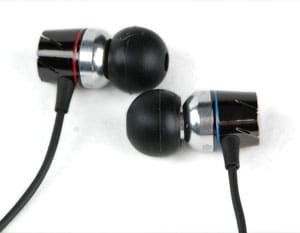
***Note the slits cut into the back of the
Turbines. These are simply for aesthetics.***
Beyond that, the ear buds have a metallic finish and the nozzles are topped with a metal mesh.
[
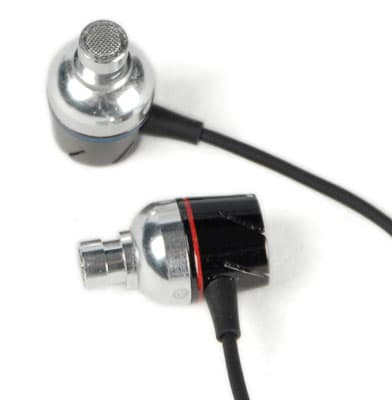
](../../images/upload/Image/Reviews/Monster/Turbines/nozzles-600.jpg)
***This is what the Turbines look like without their sleeves
on. The short, fat nozzles will likely not break easily.***
The two ear buds merge at a robust neck split.
[
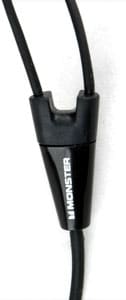
***The neck split itself is robust, but the lack
of cord guards is a durability issue.***
After the neck split, the Turbines finish off at a standard 1/8-inch plug.
[

](https://reviewed.usatoday.com/headphones/images/upload/Image/Reviews/Monster/Turbines/cord-guards-3-600.jpg)
The plug is thin, which should accommodate recessed jacks.
[
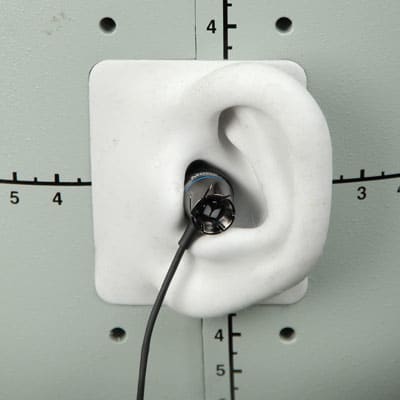
](../../images/upload/Image/Reviews/Monster/Turbines/hats-side-1000.jpg)[
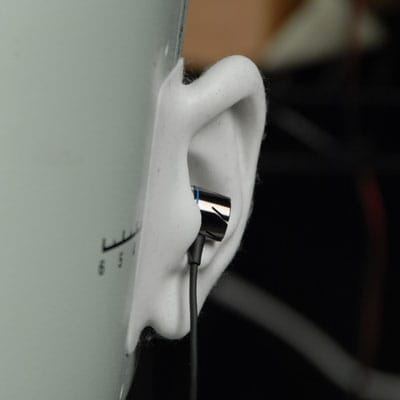
](../../images/upload/Image/Reviews/Monster/Turbines/hats-front-1000.jpg)
**This is what the headphones look like on HATS, from the side and front views. **
The Turbines come with a pouch, two sizes of triple-flanged sleeves, and three sizes of soft plastic sleeves.
[
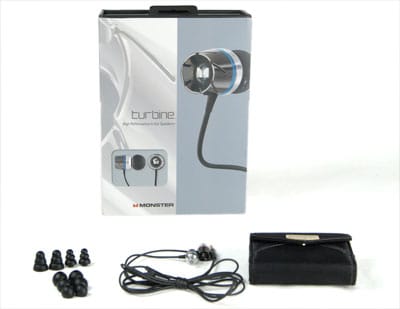
This is about standard for a pair of $150 headphones.
The Monster Turbines have one main seem robust, except for one area: cord guards. Cord guards are the semi-rigid bits of rubber that are located at points where the cable runs into a hard plastic surface. The cord guards serve to stop the cable from bending too sharply at that hard edge, which exacerbates wear and tear. Note that the Turbines only have cord guards after their ear buds, but don't have any at the neck split or plug.
The lack of a cord guard at the plug is especially dangerous, since it'll stick straight out of your device. As we saw on the MM 50 iPs, this could cause issues if you're connecting to a media player in your pocket. Whenever the media player moves around, the top of the plug will be rubbing against the sides of your pocket, pulling on the cable. Taking the media player out of your pocket will also pull at this junction, since you likely have some cord tucked into your pocket that will catch on the fabric and create resistence. Bad cord guards are the #1 killer of in-ear headphones.
Other areas of the Turbines seem durable. The ear buds are solid, the nozzles are thick and stout (unlikely to snap off), and the cable is about as thick as you'll see on a set of in-ears.
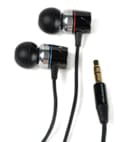
Aesthetics*(7.00)*
The Turbines are a set of nice-looking in-ears. The 'turbine' design is attractive, as is the glossy black plastic towards each ear buds' back end. In-ears don't have a lot of surface area to design for, but Monster has done a good job with what was available.
Performance
About our testing:
For our testing, we utilize only the finest robots and computer programs. Our resident robot, HATS (head and torso simulator), has precision microphones in his anatomically-similar ears. Our computer program was developed by our pals at ListenInc., and is known as SoundCheck. This program ensures we perform identical testing procedures each time. It also analyzes the data that HATS sends back to it, producing all the pretty graphs you'll see below. If you are a curious cat, you can find more information about our tests here.
**Frequency Response** *(6.59)* [

](https://reviewed.usatoday.com/headphones/content/How-We-Test-149.htm#Frequency_Response)
How the test works:
Our frequency response test measures the amount of emphasis or deemphasis the headphones will add to your playback. To do this we play a frequency sweep through the headphones. HATS listens to the headphones and relays what it hears back to SoundCheck. Using this information, we can get a detailed chart of exactly how the headphones are altering any given frequency.
What we found:
The Turbines did well here for the most part. They emphasize bass like crazy, and therefore might sound a bit boomy to some. Fortunately, they reel it back a bit and fall within the limits until just before the 10kHz mark. At this point the right channel takes a 10dB drop for a short stretch. This means that any instrument using this frequency will likely sound a bit dull, more so in the right ear than the left. After the scoring limit ends, the graph generally trends downwards, meaning the brilliance of some instruments might be a bit understated.
Other than the downward spike near 10kHz, the Turbines did well on this test. Fans of booming bass should pay particualar attention to these things.
How the Monster Turbines compare:
The Turbines had the best frequency response out of all our comparison headphones. Typically in-ears don't do well on this test compared to full-size headphones. There are many reasons why this is the case, including tiny drivers and being particularly finicky with regards to positioning – all we know is there's a trend towards poor frequency response. The Turbines prove to be an exception to the rule, with a score that's better than most on-ear or over-ear headphones. The only comparison headphones below that came close to the Turbines were the MM 50 iPs, which are currently our highest rated in-ear headphones.

](https://reviewed.usatoday.com/headphones/content/How-We-Test-149.htm#Frequency_Response)
How the test works:
Distortion is bad. It refers to differences between the original waveform and the one that HATS hears. The level of distortion will be more or less noticeable based on the type of music you prefer. Do you prefer metal or punk? Chances are you won't notice much unless there's something seriously wrong, since the instruments are distorted to begin with. Do you like classical? You will notice distortion, even in minor doses. We measure distortion as a percentage at any given frequency, with separate measurements for the left and right channels.
What we found:
The Turbines had ok distortion control. Throughout, the levels of distortion never rose far above 1%, and mainly stayed below 0.5%. If you listen to a lot of vocals, you might notice something a bit funny on a track you know particularly well. Differences would also be apparent if you switched between these headphones and headphones with lower distortion. The average consumer might not notice the difference, but chances are, if you're actually reading this section, you aren't the average consumer.
How the Monster Turbines compare:
Unlike frequency response, there's no real trend towards high or low levels of distortion on in-ear headphones. As you can see from the chart below, the range is quite large.
In a group of its peers, the Turbines fall on the below average side, and not just because the two Sennhieser in-ears received outstanding scores. The current average score for this section is a bit over 5, so while the Turbines didn't perform horribly, they could do with some improvement.

](https://reviewed.usatoday.com/headphones/content/How-We-Test-149.htm#Tracking)
How the test works:
Our tracking test measures the relative difference in volume levels between the left and right channels (ear buds/cups). Even though headphones emphasize/deemphasize individual frequencies, as illustrated above, those alterations should happen uniformly across both channels.
On the graph below, the blue line should, on a perfect pair of headphones, be horizontal at the zero mark. When it drops below zero, the right channel is louder, and when it raises above zero the left channel is louder. We do not score the extreme low and high end of the graph pictured below, because the data isn't 100% accurate. We do, however, show the full spectrum, to give an idea of the general performance trend.
What we found:
The Turbines didn't do a bad job here. The right channel seems to be slightly louder than the left during the low and middle frequencies, with the left channel growing louder a little before the 1000Hz mark. These skews towards the left and right channels are slight, however, staying within a 4dB range. The sudden hump just after 100Hz is the sharpest incline and decline up until 10kHz, and it's not a particularly big swing.
Towards the 10kHz mark the graph goes a bit funny, but that's normal and not particularly accurate. Really, the most significant bump here is after 100Hz. While it moseys a little afterwards, the changes aren't particularly sudden or stark.
How the Monster Turbines compare:
The Turbines' peers had slightly better tracking on average. Note how flat their lines are in comparison. The only one with a similar jump is the AH-C351s, but it was a bit smaller. Despite only beating the V-MODAs on the list of headphones below, the average score for this section is a bit under 7, so the Turbines are still slightly over average. Unless you're particular about your headphones, the Turbines' tracking won't bother you.
**Maximum Usable Volume** *(9.73)* [

](https://reviewed.usatoday.com/headphones/content/How-We-Test-149.htm#Maximum_Usable_Volume)
How the test works:
We define maximum usable volume as the loudest your headphones can get without outputting more than 3% distortion. As volume increases, distortion magnifies, and 3% is a noticeable amount. This test is simply a battery of our distortion tests, held at varying decibel levels.
What we found:
The Turbines were capable of outputting 118.87 decibels, which is a good amount. We award max points for 120dB: anything over that is downright harmful, regardless of how distortion-free it is. This is actually a bit quieter than many in-ear headphones, which typically output over 120dB, but a difference of one decibel and change isn't a particularly large gap.

](https://reviewed.usatoday.com/headphones/content/How-We-Test-149.htm#Isolation)
How the test works:
Isolation refers to how easily a pair of headphones can block out external sounds. There are two types of isolation: active and passive. Passive isolation comes from your headphones creating a physical barrier between your ear drums and the outside world. Active isolation, or active noise cancellation, is a feature that uses fancy science to actually cancel out incoming sounds. Typically these headphones have microphones that listen to your surroundings, then plays back an inverse-amplitude sound along with your music. The inverse amplitude collides with the incoming sound, resulting in a flat(ish) sound wave, i.e. something you can't hear.
This test is performed by blasting a headphone-wearing HATS with pink noise, then measuring how much sound of any given frequency makes it through to HATS ears.
What we found:
The Turbines do an ok job of isolating for a pair of in-ears. Like all other in-ears, they do a great job above 1kHz and a significantly less great job below it.
In-ear headphones, which are essentially ear plugs, have a tendency to isolate better than all other headphones, including those with active noise cancellation. This being said, active noise cancelling headphones excel at blocking out low-end noise. Active cancellers also block out far less middle or high frequency noise and block out less noise overall.
active cancellation typically blocks out far more bass noise, but not as much middle or high-end noise.
How the Monster Turbines compare:
In-ears have the potential to block out a lot more noise than the Turbines did, but they still didn't compare badly to their peers. The only headphones that blocked out significantly more noise were the SE420s and their foam ear buds (if the sleeve looks like an actual ear plug, chances are it'll perform like an actual ear plug). The Turbines ended up coming out on the top half of the comparison headphones below, but just barely. Compared to all headphones, the Turbines are way above average, but compared to other in-ears, they had solidly average isolation.

](https://reviewed.usatoday.com/headphones/content/How-We-Test-149.htm#Isolation)
How the test works:
Leakage refers to the amount of sound that escapes the ear-headphone seal. While leakage isn't a problem in a room by yourself, if you're looking to listen to a movie while a room mate sleeps, or if you want to listen to music in the library, then you want headphones with low leakage.
This test is performed by playing pink noise through the headphones, which are worn by HATS. A microphone placed a set distance away captures any sound that escapes.
What we found:
The Turbines performed well enough here, although they were below average for a set of in-ears. Typically in-ears score closer to our max score of 10. Chances are the Turbines would be fine to listen to at a moderate level in just about any public setting, although if you're in a silent library those around you7 might hear a whisper of your music. If you listen at a louder level, you'll only annoy everyone further.
In Use
The Monster Turbines were of average comfort for a set of in-ears, but had one fatal flaw: they pop out of place ridiculously easily. If you accidentally tug them, they'll come loose. If you twist your head too far, they'll come loose. These are not good jogging headphones.
Even just sitting, not moving, the Turbines will gradually fall out of place over the course of a few hours. We weren't particularly annoyed by this because the ear buds only popped out of place a few times over the course of a 6-hour listening session, but the fact that they came out at all when we were sitting stock still was surprising.
**Cable Connectivity***(3.91)*
The Turbines have a cable measuring 3 feet, 9 inches (1.14 meters). This is an average length for a set of in-ears. Also typical is the absence of any adapters. The cord is very thin, however, which means all you first-generation iPhone users (or any other device with a recessed headphone jack) are all set.

The Turbines end in a standard, thin 1/8-inch plug.

In-ear headphones are just about as portable as a set of wired headphones can get. The Turbines don't have a super short cord, meaning there are a few more portable options for those that keep media players in arm bands or a lapel pocket. Many users will probably prefer the Turbines' cord length, however.
The Turbines do come with a pouch, but it isn't a particularly good one. It looks a lot like a change purse, with open sides that are held together with an elastic strip of fabric. This means the pouch is really only good for holding the headphones, because if it turns upside-down all the sleeves would spill out. The ear buds typically stay on the Turbines, so we're not particularly worried about those falling out, but it remains a possibility. The pouch also has no means of managing the cord, meaning you'll have to ball the Turbines up and shove them in. Pouches that are simply pouches are nice because they're free, but for the most part they're useless. If you keep the headphones in the pouch, it just means you'll have to carry around an empty pouch while the headphones are in use, and the pouch itself takes up more pocket space than the headphones alone would.
The Turbines come with small, medium, and large soft plastic sleeves and two sizes of triple-flanged sleeves. This should help you find the fit and style that you like, but the selection is a bit sparse for $150 headphones. Compare the Turbines' customization options to the Shure SE420s, which come with three sleeve types and also an optional in-line volume dial.
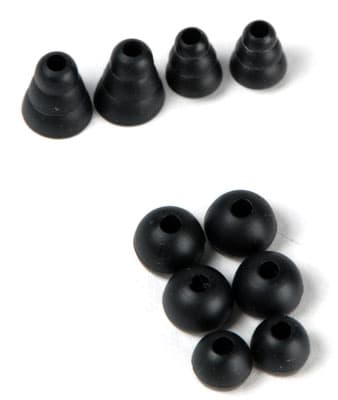
***Above are the sleeve options for the Turbines. Triple-flanged sleeves
are better than the soft plastic ones if you're looking for isolation.***
Like most in-ear headphones, the Turbines can't be taken apart to any extent to fix or modify them. You can remove the sleeves to help clean them without getting any internal components soggy. Some in-ears come with cleaning tools or removeable wax guards to protect the nozzles, but the Turbines do not.
Battery Dependency
The Turbines do not requires a battery, netting them some points. Batteries are annoying, often die at inopportune times, and either require recharging or a repeated additional investment.
Value & Comparisons
[
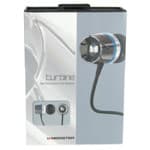
](http://headphoneinfo.com/images/upload/Image/Reviews/Monster/Turbines/box-1000.jpg)**Value***(4.50)*
Monster has a reputation for slinging overly expensive products. The Turbines serve to single-handedly shatter this popular belief, because they cost only slightly more than they should. If you're looking for a set of in-ears in this price range, there are slightly better headphones out there, like the Etymotic 6isolators or Sennheiser CX 95s, but the Turbines have most of them beat in terms of style.

[

Sennheiser CX 95](https://reviewed.usatoday.com/headphones/content/Sennheiser-CX-95-Headphones-Review-680.htm) - The CX 95s are better headphones in just about every regard, including price, but are aesthetically plain. Check them both out and listen to how each sound. Unless the Turbines really strike you as amazing, get the CX 95s, because they're a better deal with better sound quality.
[

Shure SE420](https://reviewed.usatoday.com/headphones/content/Shure-SE420-Headphones-Review-668.htm) - The SE420s are also better headphones, but unlike the above comparison, the Turbines have them beat on price. That's likely the factor that this match-up will come down to, although the Turbines are also a bit more attractive than the SE420s.
[

V-MODA Vibe Duo](https://reviewed.usatoday.com/headphones/content/V-MODA-Vibe-Duo-Headphones-Review-451.htm) - Roles have been reversed, and this time the Turbines are the bigger, better, more expensive version. In this case, however, the Vibe Duos really aren't significantly worse – at least enough to justify the extra $50 you'd shell out for the Turbines. Again, unless you hate the Vibe Duo's design, we'd recommend them over the Turbines.
[

Denon AH-C351](https://reviewed.usatoday.com/headphones/content/Denon-AH-C351-Headphones-Review-389.htm) - This match-up is really more about budget than anything else. At $50, the AH-C351s are very inexpensive and offer great audio quality for their price. The Turbines cost $150, look a lot better, and have better audio quality. There's no question that the AH-C351s are a better value, but if you're looking for a higher-end model, the Turbines are the better pick.
[

Sennheiser MM 50 iP](https://reviewed.usatoday.com/headphones/content/Sennheiser-MM50-iP-Headphones-Review-547.htm) - The MM 50 iPs and Turbines share a cord guard problem, which hurts both their values. Unfortunately for the Turbines, we don't think any amount of aesthetics could make them more appealing than the MM 50 iPs. These headphones have better audio quality than a lot of full-size models, surprisingly, and are very inexpensive comparative to their audio quality at $100.
Conclusion
Conclusion

The Monster Turbines have the unfortunate position of being better than average at a price point full of excellent headphones. They received good scores and aren't too overpriced, but then again we really couldn't recommend them over all the other, better options around this price point. If you really like the way they look, or have already bought them, then don't fret: they aren't bad. They simply aren't as great as some of the other headphones you could've bought for a bit less money.

The Audiophile crowd won't like all the distortion on the Turbines.
The Turbines certainly are portable. They could've used a better case, or had slightly better isolation, but overall they remain a good pick for portable users.
While we would recommend these to an airplane traveler because they're portable and have better than average isolation (without needing batteries), we also want to point out that many in-ears can isolate much better.
These headphones aren't great for home theater use. They're small, fall out easily, have a short cord, and aren't capable of creating a large soundstage.
Meet the tester
Mark Brezinski works on the Home Team, reviewing refrigerators, minifridges, dishwashers, washing machines, dryers, air conditioners, air purifiers, and fans.
Checking our work.
Our team is here for one purpose: to help you buy the best stuff and love what you own. Our writers, editors, and lab technicians obsess over the products we cover to make sure you're confident and satisfied. Have a different opinion about something we recommend? Email us and we'll compare notes.
Shoot us an email
